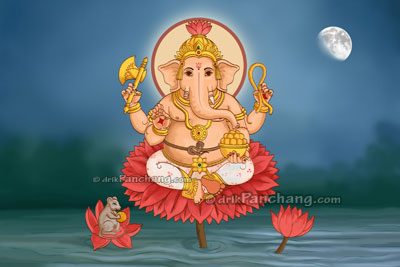
























 Moonrise on Sankashti Day - 08:35 PM
Moonrise on Sankashti Day - 08:35 PMNotes: All timings are represented in 12-hour notation in local time of Cambridge, United States with DST adjustment (if applicable).
Hours which are past midnight are suffixed with next day date. In Panchang day starts and ends with sunrise.
In Hindu Panchang, each lunar month in Hindu calendar has two Chaturthi Tithi(s). The one after Purnima or full moon during Krishna Paksha is known as Sankashti Chaturthi and the one after Amavasya or new moon during Shukla Paksha is known as Vinayaka Chaturthi.
According to Amanta Hindu Panchang, Krishna Paksha Chaturthi of Magha month (Purnimanta Phalguna month) is known as Dwijapriya Sankashti Chaturthi. Sankashti means getting rid of trouble. On this day, Dwijapriya Ganesha form of Lord Ganapati is worshipped. On Dwijapriya Sankashti Chaturthi, devotees of Parvati Nandan Ganesha Ji observe a difficult fast to receive His blessings. Chandrodayavyapini Chaturthi Tithi is considered for observing this fast.
According to religious beliefs, on the divine occasion of Dwijapriya Sankashti Chaturthi, worshipping Lord Shri Ganesha, the destroyer of obstacles, removes all kinds of obstacles in life.
On the day of Sankashti Chaturthi, devotees of Lord Ganesha observe a strict fast from sunrise to moonrise. In this fast, worshippers of Lord Ganesha consume only fruits and roots or plants growing inside the ground. Therefore, Sabudana Khichdi, potatoes and peanuts etc. are considered suitable food in this fast. Dwijapriya Sankashti Chaturthi fast is broken only after Chandra Darshan.
According to the Hindu calendar, in the northern Indian regions, Sankashti Chaturthi of Magha month is celebrated with great joy as Sakat Chauth. Apart from this, devotees of Lord Ganesha celebrate Vinayaka Chaturthi in the month of Bhadrapada with great pomp as the birth festival of Lord Ganesha, this birth festival is known as Ganesha Chaturthi.
At the time of Satya Yuga, there was a king named Yuvanashva. In his court, there was a Brahmin named Vishnu Sharma, who was an expert in all the scriptures. Vishnu Sharma had seven sons and seven daughters-in-law. With the passage of time, Vishnu Sharma grew old, and his age deteriorated. Due to his age, his six daughters-in-law rejected him one by one, but the seventh or the youngest daughter-in-law started serving her father-in-law with full devotion.
Vishnu Sharma was a man of immense knowledge, so being satisfied with the service, he told his daughter-in-law about the Sankashti Chaturthi Vrat and instructed her to observe the fast. As per the instruction of her father-in-law, the younger daughter-in-law observed the Dwijapriya Sankashti Chaturthi fast with full devotion and because of this fast, after living a blissful life full of all kinds of material comforts, she attained salvation at the end. Therefore, to obtain the special blessings of Lord Ganesha, one must observe the fast of Dwijapriya Sankashti Chaturthi.